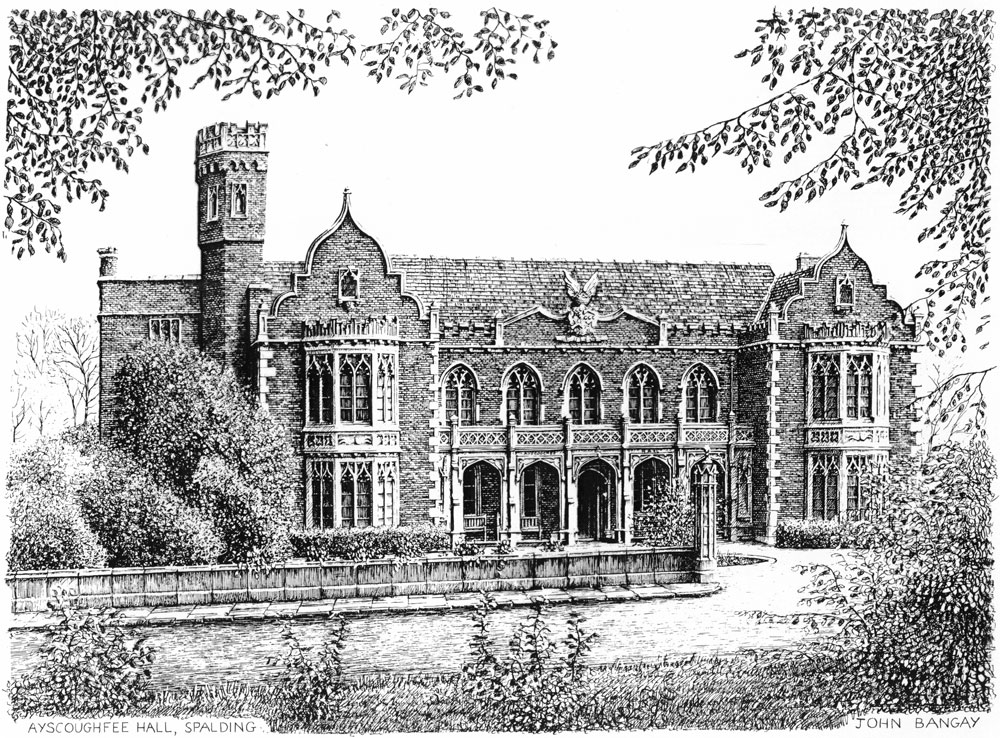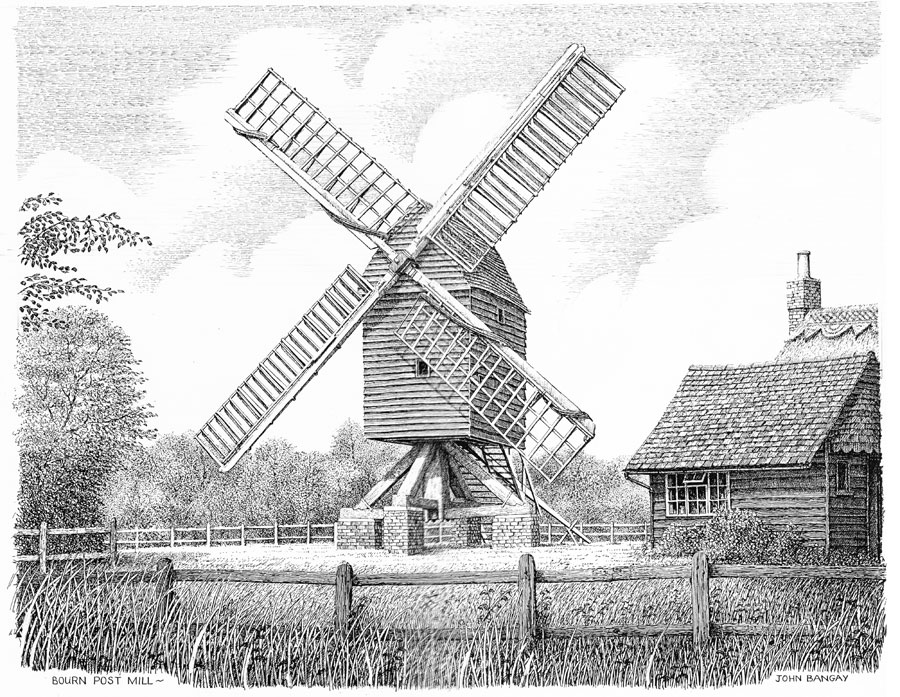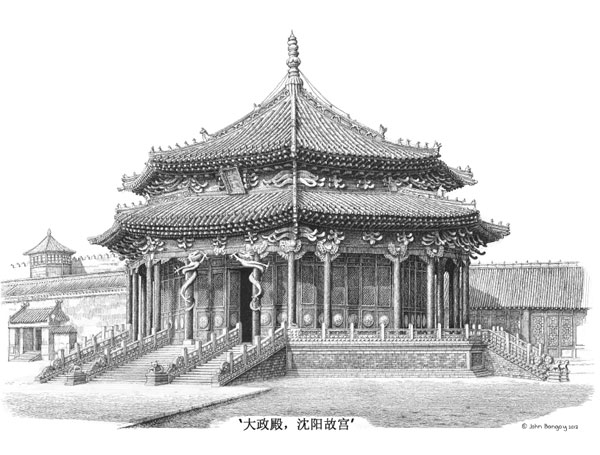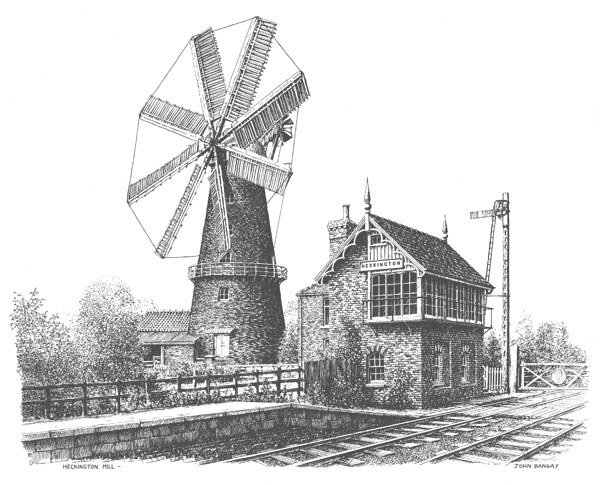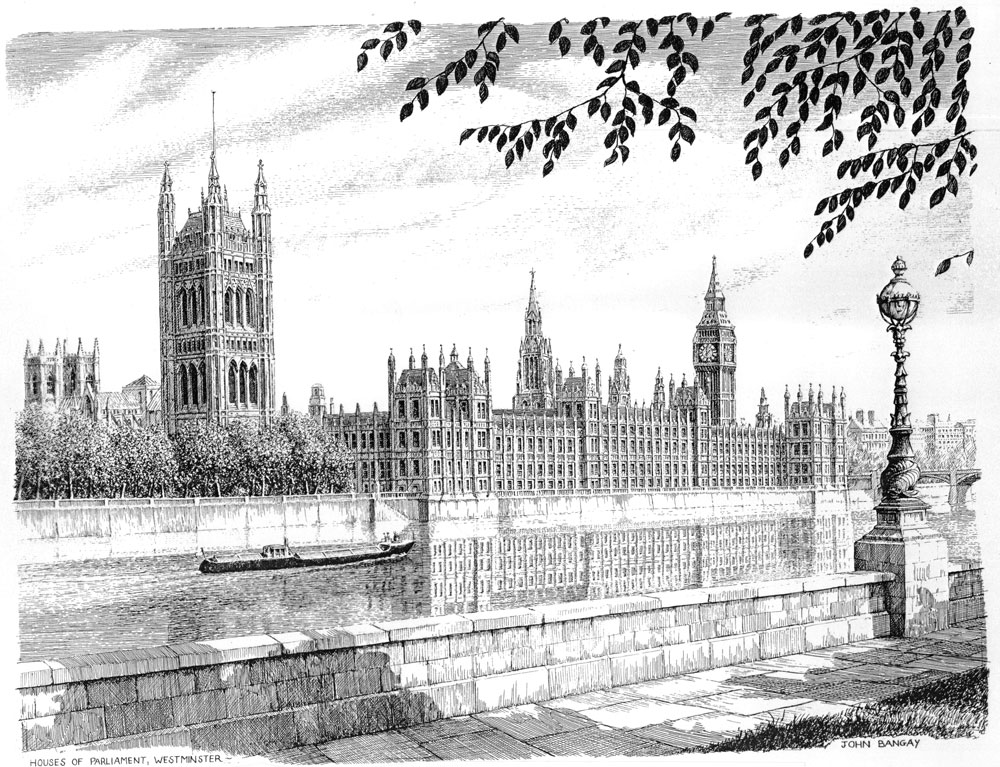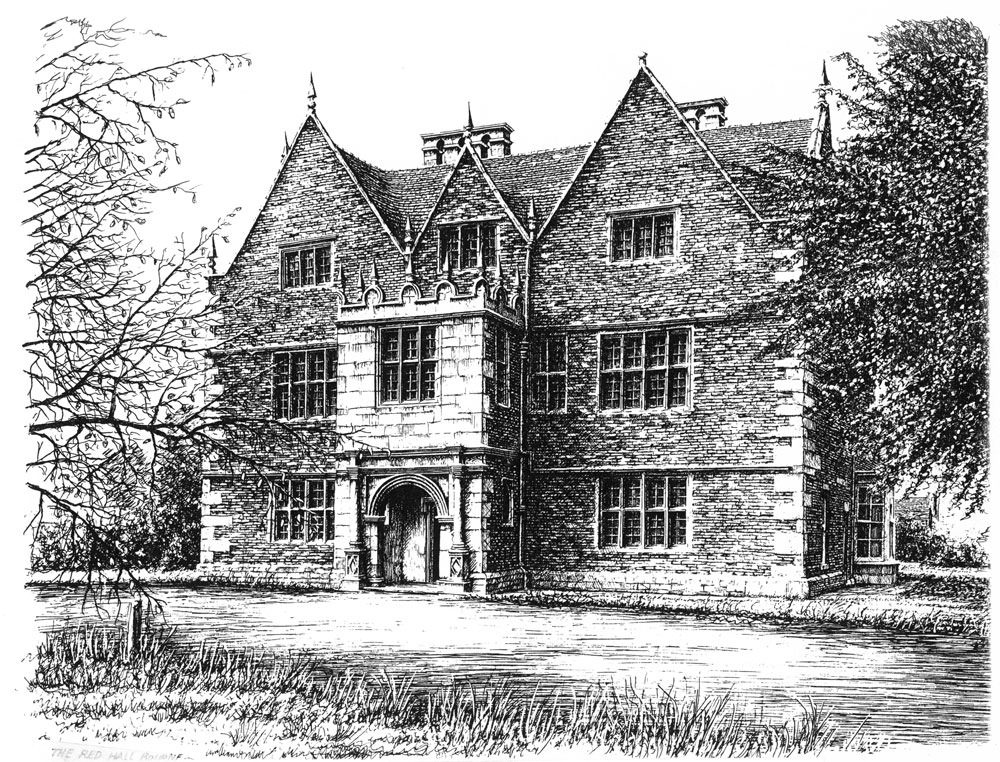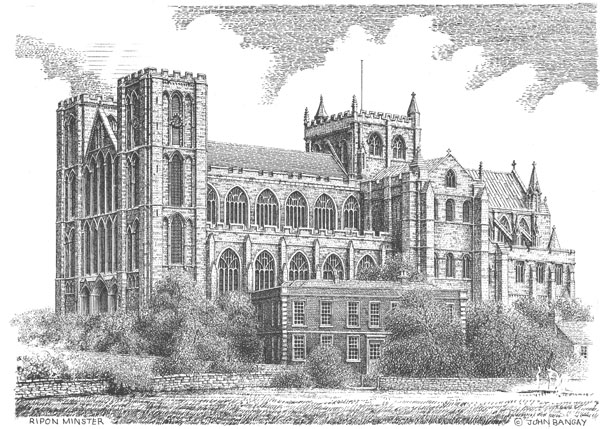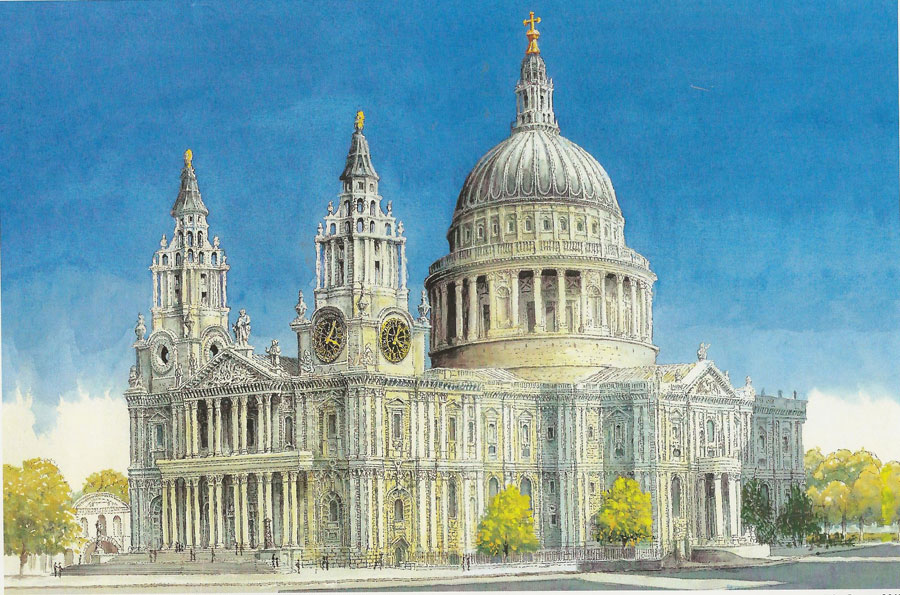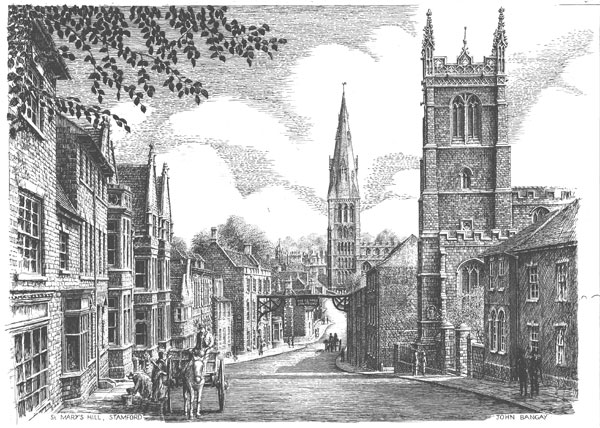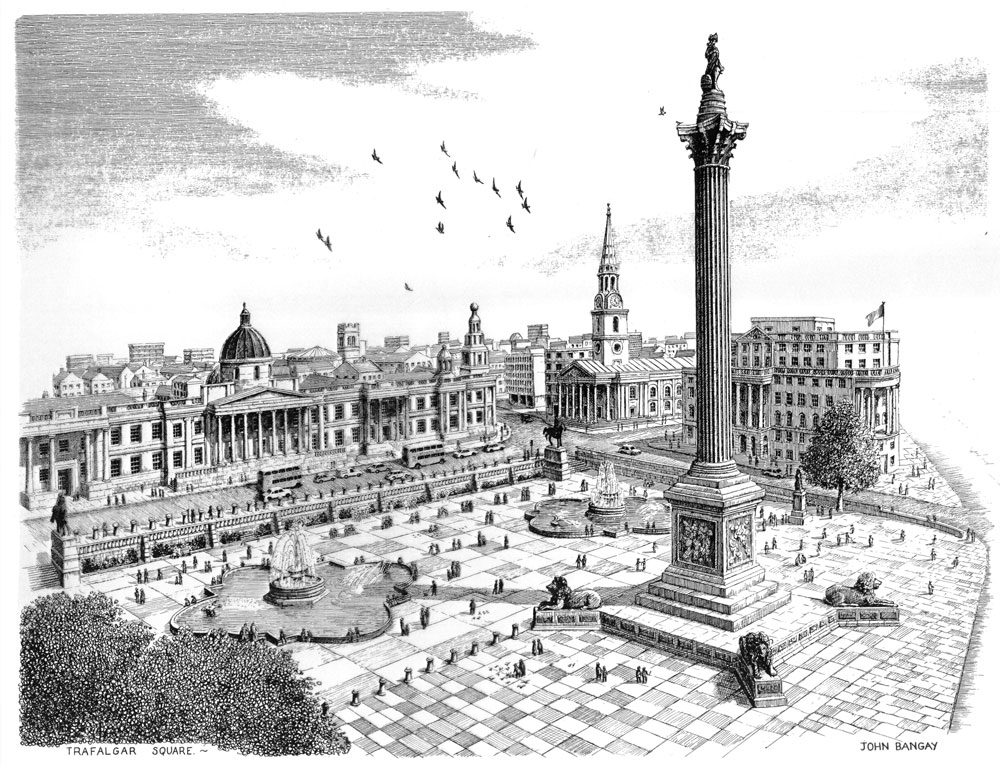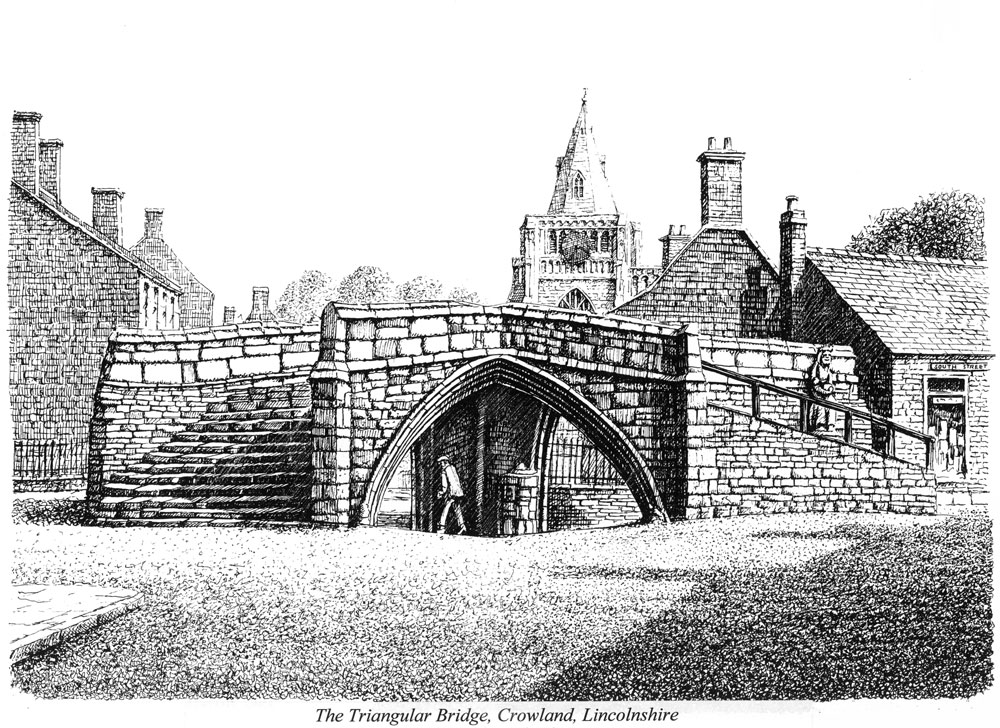Reproductions of John’s work are currently sold mostly in Cathedrals, Churches and other Historical buildings gift shops, as well as directly through this website.
This catalogue is divided into four sections; Cathedrals and Churches; Wind and Watermills; Other historic buildings and Christmas Card sections. You can purchase any of his prints below directly from John. Please give drop him a line here.
Alford Manor House, East Lincolnshire, is believed to be the largest thatched manor house in England and was built to a traditional H plan in 1611. It is a very rare example of a composite structure, featuring a wooden frame with reed and plaster (visible from within the house), encased in brick. Ground-floor and first-floor rooms feature design interventions from Georgian through to Victorian times, while the attic floor is virtually untouched since 1611. It was encased in brick, and the brick was not merely ornamental: it was tied into the structure of the building via wall plates and floor joists.
The house owes much of its existence to the wealth of one of its owners, Sir Robert Christopher. Christopher fought for the Royalist cause in the English Civil War and was knghted by Charles If following the restoration. The house was inherited by his granddaughter, Lucy. Thereafter Alford Manor House was inhabited by tenants, one of whom was John Higgins, who arrived in about 1820. He was a friend of Charles Darwin’s father, Robert, and was the local Land Agent. He established his office in the nineteenth century annex which you can be seen in the east wing of the house. It was eventually donated to the local community and is now managed by Trust.
Print No. 128
Alford’s last surviving windmill is a fine working example of a traditional 5 sailed Lincolnshire Windmill with its distinctive Ogee Cap and balcony. It is known as Hoyles Windmill and is currently (2016) in full working order. It was built in 1821 for a Mr Oxley, who was later killed while working on another windmill at Barrow on Humber. The mill’s preservation was famously put at risk early in the last century when a fire started in the night, on the ground floor, and the miller was luckily woken by a baby’s crying, saw the fire and extinguished it before it could take hold. The charred timbers can still be seen in the mill today. The mill has 6 floors and four sets of millstones.
Print No. 030
Only the 90 ft. high Perpendicular tower of the medieval church remains. This has been incorporated into the 18th century rebuilding, begun in 1736, probably by Francis Smith, inspired by the style of London’s St. Martins in the Fields. The interior is light and contains gently painted walls and a similar ceiling. The older medieval church was larger and its ground plan can still be seen in the surrounding churchyard.
Print No. 131
Alvingham, near Louth, in north Lincolnshire, has had a watermill on or near this spot since before the Doomsday Book was written. It has a waterwheel 11 feet in diameter and 8 feet wide. It is currently in private hands.
Print No. 031
Originally built around 1420 by Richard Alwyn, whose son, Sir Nicholas, was Lord Mayor of London in 1499. It later became the home of the Askew family from whom it gets its name. One tragic member if this family, Anne Askew, a religious protester during Henry VIII’s reign, was burnt at the stake for promoting her reformist views. The hall later became the meeting place for The Learned Gentlemen’s Society, a literary group founded by Maurice Johnson around 1702. The Hall was rebuilt under Johnson’s direction in a style heavily influenced by Indian architectural style and his crest, with outstretched wings, surmounts the top of the façade.
Print No. 050
Bardwell Windmill in Suffolk was originally built in 1823 and worked by wind until 1925 when the mill was converted to work by oil engine. By 1978 the mill was derelict but was bought and restored by James Waterfield in 1985. It was then sold to the Wheeler family in May 1987, but in the great gale of October 1987, it was badly damaged. It was gradually repaired, partly with grants from English Heritage an Edmundsbury Council. Volunteer labour helped make new sails and the mill is now fully restored. It has four double patent sails, a cast-iron wind shaft and wooden brake wheel. Every year it hosts a steam threshing festival.Jonathan Wheeler / jwheeler@wheeler-steam.co.uk / 07929648369
Print No. 124
Belton is considered by many to be the perfect example of an English Restoration-style country house. Despite its appearance it was not designed by Christopher Wren but by a contemporary, Captain William Wynde who, in turn, was influenced by Sir Roger Pratt’s highly influential, but now demolished, Clarendon House. It was the ancestral home of the Brownlow family for more than 300 years and their family crest, the Greyhound, still can be seen atop the central Cupola. Now a National Trust property, its interiors are still richly furnished with period style furniture and paintings, including a masterpiece by Frederick, Lord Leighton.
Print No. 051
Belvoir Castle sits high on a hill above the beautiful Vale of Belvoir, one of England’s most romantic and beautifully situated stately homes.
Print No. 092
Beverley Minster is often regarded as one of the finest examples of English Perpendicular Architecture, rivalling the Decorated qualities of York Minster a few miles away. Originally founded by St. John of Beverley, who died here in 721, his relics were rediscovered in the 17 th century and are now buried in a grave marked by a marble slab in the Nave The minster has endured destruction by Viking raiders in 866 and was rebuilt in a variety of Early English, Decorated and, most magnificently, Perpendicular styles, especially the west front with its 163 feet high twin towers and superb richly decorated nine light west window. Its arch is bounded by a sweeping crocketed canopy, terminated in delicate finials.
St. Botolph’s Church gets its popular name from its stumpy appearance. It is England’s largest purpose-built parish church, due largely to the riches of the port of Boston in medieval times. Its tower rises to 272 feet and John Taverner, the Elizabethan composer, is buried at its foot.
Print No. 003
Built in 1821 by Bryan Browning, it employs an ingenious design in a limited space. He set the horseshoe-shaped stairs ascending to a grand entrance, in the central bay, framing them within a screen of Doric columns, in the style of a Roman bath. The weathervane above represents the arms of the great English warrior, Hereward the Wake, who fought against the Norman invaders and who, according to legend, was born very close to this spot.
Print No. 095
Bourn Post Windmill is one of the oldest surviving post windmills in England, It is located to the west of Cambridge. The mill has been restored over the years to ensure that it is preserved in full working order..
The windmill was given to a windmill charity in 1932. It dates back to at least 1636, although it may be much earlier as this type of mill design has hardly changed since the 13th century.
Bourn Mill is an open trestle post mill; the entire weight of the body is supported on a central post, which is then supported by a trestle. The sails of the mill have to face squarely into the wind and to achieve this, the entire mill is rotated around the central post by means of a tailpole arrangement.
Print No. 032
Buckingham Palace was originally built for John Sheffield, The Duke of Buckingham in 1763. It was later bought by George the Third as a royal London residence for his wife, Queen Charlotte. It was enlarged and styled by John Nash in the 1820’s and eventually Queen Victoria made it her principle London residence in 1837. In 1851 the famous central balcony was used for the first time by Queen Victoria during The Great Exhibition in nearby Hyde Park. It is now the London home of the reigning monarch. It has 775 rooms, 52 bedrooms and 19 state rooms.
Print No. 136
Burgh Le Marsh, Lincolnshire, St Peter and St. Paul Church.
Burgh le Marsh church was built in the 14th century. It has a fine wood Jacobean pulpit and a lectern carved in oak by Jabez Good in 1847, a barber and local historian who lived in the town. The peal of eight bells can regularly be heard and local customs of ringing the ‘Shriving Bell’ on Shrove Tuesday and the ‘Passing Bell’ on the death of a local person are still maintained to this day. Also from October to March the ‘Curfew’ bell is rung. Externally the impressive clock face warns ‘Watch and pray for ye know not when the time is’.
Print No: 122
Originally built around 1830 by a Cambridgeshire firm of millwrights, the mill has passed through the hands of several millers until 1930 when the last millwright, Mr Frank Dobson, took over, running the mill in conjunction with Grebby Windmill. The mill is unusual, but not unique, in having left-handed sails and, because the control chain hangs to the ground, there is no need for a balcony. The mill had its own bakery which made it quite profitable along with an interesting side-line, especially in the Edwardian era, providing feedstuffs for the horses which pulled the bathing vans in and out of the sea at nearby Skegness.
Print No. 033
Burghley was built by Lord Burghley, Queen Elizabeth’s great principal minster and is generally regarded as England’s finest Elizabethan property. It houses a wonderful collection of 17th century Italian paintings and is surrounded by magnificent parkland, sculptured by the landscape gardener, Capability Brown. This is one of my earliest drawings done in 1975 and the foreground tree on the left is an artistic addition to enhance the composition.
Print No. 053
The most easily recognisable architectural icon on the North Norfolk Coastline, it ceased milling operations in the 1930s and since then has been a family home. In this drawing I have restored the shades in the sails as they would probably have appeared in its working days.
Print No. 035
Cogglesford Mill, Sleaford is the last Sheriff’s watermill in England. There has been a watermill on or near this site for over a 1,000 years and the Doomsday book records 18 watermills on this stretch of the river Slea. They were known as The Sheriff’s Watermills, owned by The Bishop of Lincoln, the most valuable watermills in the area.-and this is probably the last surviving Sheriff’s watermill in England. The present mill house was built around 1750, although the north wall has recycled stone from an earlier mill. Originally a single storey, an upper garner floor for storing grain was added in the 19th century accessed by pulley hoist for sacks of grain. At one time the mill had two waterwheels driving the two sets of stones but now it has only one, quite rare wooden low breast-shot water wheel, which has been beautifully preserved. There are still two sets of stones, one Millstone Grit and one French Burr.
Print No. 036
Crowland is an isolated settlement, deep in the South Lincolnshire fens. The abbey’s squat tower can be seen for miles around, along with the ruins of the Abbey, dissolved by Henry VIII and further damaged in the English Civil War by Oliver Cromwell’s cannons. The abbey was originally founded, according to legend, after St. Guthlac, whose boat drifted ashore nearby on a gloomy winters afternoon (at Church Anchor Field) . The Abbey was founded in his memory in 718 and eventually grew to be an important monastic foundation.
Print No. 006
The Dazheng Hall is part of The Shenyang Imperial Palace, built in 1625, after the Forbidden City in Beijing, it is the largest Palace complex in China. It was in this hall 1644 that Shunzhi was crowned the first Qing Emperor of China. Dazheng Hall was mainly used for grand ceremonies like the Emperor’s enthroning, imperial edict issuing and welcoming the return of triumphant troops. The hall faces a large open space, flanked by the eight flag pavilions of the army commanders and the Emperor would stand at the top of the steps, flanked by two sinuous golden dragons, while his army knelt before him. .Architecturally, the Dazheng Hall is simply a pavilion, but is large in size and gorgeously decorated.
Print No. 091
‘Half a house of God and half a Castle ‘gainst the Scots’ is how this great building was once described, on its craggy perch above the River below. Its architectural style is mainly early English and its interiors bear a mysterious resemblance to a mosque in the way the close-arched pillars overlap.
Print No. 007
Dyke Smock Windmill, near Bourne, Lincolnshire.
This is a reconstructed drawing of how the mill, a mile north of Bourne in south Lincolnshire, may have looked during its working days. Only the central tower remains, currently a small art gallery. It was originally built as a drainage windmill on the nearby fen but was later dismantled and brought up into Dyke village where it was reconstructed as a corn Windmill.
Print No. 115
Ellis’s Windmill is the last of a line of windmills which once stood on a city-edge escarpment overlooking the city’s west common. It is named after the last commercial miller and has four double patent sails. The wagon in the foreground is a traditional south Lincolnshire hay wagon.
Print No: 088
Unique and often mysterious, with its celebrated lantern design, it is a glorious mixture of mainly early English architectural design. Its position, sitting on an isolated island in the East Anglian Fens, plus it association with Hereward the Wake, has made it one of England’s most romantic buildings. The name ‘Ely’ may be derived from the Greek ‘Elysium’, meaning ‘Paradise’.
Print No. 008
This is one of my earliest drawings, made in 1973, when I first began selling my pictures on the streets around Lincoln Cathedral. Exchequergate is a rare surviving example of a cathedral close gateway which guarded access to the cathedral. Medieval pilgrims, arriving to visit the shrine of St. Hugh, might pause beneath the central arch to buy souvenirs or indulgences, pardoning them from their sins.
Print No. 123
In this painting my daughters modelled the sledge-pushing activities! In winter the cathedral shimmers brightly in the winter sunshine, making the cool yellow limestone stand out even more against the blue sky. The area in the foreground, known as Castle Square, saw much violence and upheaval in the wars between Stephen and Matilda, and later, during the Pilgrimage of Grace.
This drawing, made in 1976, is based on an old photograph showing the western elevation of the building, before it became hidden by trees. The great medieval kitchens are contained in the section on the right, while, in the centre, the external view of the great hall can be seen. Since this drawing was made, the Old Hall has been much restored and I hope to produce a new drawing soon, from the other side.
Print No. 056
Great Chishill is an open trestle post type windmill with an external fantail, one of only five still remaining in Great Britain. The local village was granted a 125 year lease from the owners, Cambridgeshire County Council, and are urgently trying to raise money to save and preserve this ancient mill, currently in poor condition. If you would like to help please visit: http://www.greatchishillwindmill.com.
Print No. 034
The Stonebow marks the site of the old Roman south gate into the old Roman city of Lindum Colonia. It was built as the principle entrance to the medieval city of Lincoln and, upstairs is the old room in which the city council would meet. It still contains the ceremonial sword, presented to the city by Richard II.
Print No. 073
This extraordinary building was built in the 19th century to a design by its first owner ,Gregory Gregory. He studied many different designs and combined them into this almost unique great English country house. It is now part of a university campus and is therefore often referred to as ‘Harlaxton College’.
Print No. 057
The Harlequin is a former medieval Inn which stands halfway up Steep Hill, Lincoln, at a point just below the south gate of the old upper Roman city of Lindum. Thus it would have probably begun life as a typical Ale-House outside a city gate. Excavations in its cellars once revealed a cannonball, probably from the guns of Oliver Cromwell, when he laid siege to the city during the English Civil War. It is now an antiquarian bookshop.
Print No. 069
Heckington is England’s only eight-sailed windmill and is in fact a combination of two windmills. The original Heckington five sails were removed early in the 20th century and a set of eight sails from a mill on Boston Docks were brought and installed on this tower. The sails provide immense power and can turn in only a slight breeze.
Print No. 038
Sometimes known as ‘The Cathedral of the Fens’, this beautiful Decorated style church was built early in the 14th century and embellished by Richard de Potesgrave, chaplain to both Edward I and Edward II. It has many fine stone carved figures and inside, on the north side of the chancel is a beautiful Easter Sepulchre, one of the finest in England. Also in the chancel is the recessed tomb of Richard de Potesgrave, builder of the chancel. The combination of the Sepulchre, Sedilla, and contemporary Piscina has been reckoned to be the finest such Decorated style grouping in existence.
Print No. 097
On October 16th 1836, a fire broke out in the old Palace of Westminster. It destroyed much of the building and so plans were called for a new palace. Plans for a style similar to the American senate were dismissed because of the republican connections and a Gothic theme with its connection to romantic chivalry and English history was chosen. Charles Barry won the competition (and £1500 prize) with his neo-gothic design, aided by the brilliant Augustus Pugin who added the external embellishments of spires and finials, as well as extensive internal decorations. The foundation stone was laid in 1840, the House of Lords opened in 1847 and the Commons in 1852, but work dragged on until 1870. The Victoria Tower is the tallest of the three towers, containing the documentary archive. The Elisabeth Tower is better known as Big Ben, the clock tower, housing the remarkably accurate great clock, designed by Edmund Beckett Denison.
Print No. 139
Castle Square, in the foreground, has seen many tumultuous events, standing as it does, halfway between the cathedral and the castle. It is crossed by the main street of the old Roman upper city and later it was the scene of a great siege between the forces of King Stephen and The Empress,Matilda. Later still, the leaders of the Pilgrimage of Grace were executed here during Henry VIII’s dissolution of the monasteries.
Print No. 013
Lincoln Castle Gate, view from inside.
I made this very early drawing, in 1974, from inside the castle, because I wanted to show the beautiful little Oriel window, seen within the arch. This was saved when a fine medieval building known as ‘John of Gaunt’s Palace’ was demolished in the 19th century in the lower city.
Print No. 009
Exchequergate, seen in front of the cathedral’s west front, is a rare surviving example of a three-arched entry gate into the cathedral precincts. It would have been the principal entry point for pilgrims wishing to visit the cathedral and souvenirs and Indulgences (paying to have sins forgiven) may have been sold beneath its arches. The twin towers date from Norman times and the south (right) tower nearly collapsed in the early 20th century, saved only by heroic efforts by the cathedral masons.
This is a reconstructed drawing of how the pool would have looked around 1900, when the great Humber Keel barges were still bringing coal and other industrial goods to the city. The Pool is now surrounded by modern, sometimes less attractive buildings. Brayford Pool is a relic of the last Ice Age and its Celtic pre-roman name of ‘Lynn’ gave rise to the Roman name of ‘Lindum’, Later ‘Lindum Colonia’ and finally Lincoln. It is part of a waterway link via the Roman canal called the Fossdyke, and the Rver Witham, all of which provides access from The River Trent to Boston and the North Sea. Wool taxation on this route made Lincoln a rich medieval city.
Product code: 015
Michealgate is one of the narrow streets on the hill leading up towards the cathedral. In medieval times it was the site of the fish market and, as its name implies, French was often the common language spoken at that time. The leaning but structurally sound house on the right is now a National Trust managed property, available to let to tourists.
Print No. 087
Perhaps the richest English cathedral in terms of innovative architectural styles, it dominates the city of Lincoln from its ‘Sovereign Hill’ as Wordsworth described it. The name Lincoln is a combination of’ Lynn’- Celtic for pool- the nearby Brayford Pool, and ‘Colonia’ when Lincoln was one of the richest Roman towns in England. Lincoln Cathedral owns the only named copy of Magna Carta, now on display in Lincoln Castle.
Print No. 012
Lincoln Cathedral from the south
Print No. 021
You can only see this lighting effect for a few weeks each summer when the setting sun moves around to the north-west- and a passing thunderstorm provides a dramatic backdrop. Lincoln’s position on its ‘sovereign hill’ makes it a dramatic subject for any painter, especially when seen through the eyes of Peter De Wint, the painter most associated with views of this cathedral. When it was topped by its three slender spires it must have been an even more dramatic and appropriately awe-inspiring sight.
Scrivelsby Court is the ancestral home of the Dymoke family, the hereditary champions of England. In past times, the Champion would ride, three times, fully armoured, into the Coronation Banquet and challenge anyone who doubted the right of the monarch to reign.
If no-one challenged the champion, he would then drink from a golden cup with the King, or Queen. The ceremony was ended by William IVth but legend has it that, on the night of major royal events, the Lion comes down from the gate at midnight, looking for food!
Print No. 141
Lutton Gowts Windmill near Long Sutton, South Lincolnshire
This is a reconstructed drawing, showing how the mill probably looked during its working life. Only the tower now remains, semi-derelict, of this very early Lincolnshire tower windmill. It stand near the old Roman bank on the edge of The Wash and it shows how tower windmills may have developed from the earlier smock windmill design. It also had a tailpole arrangement, shown in this drawing, by which the mill was pushed around.
Print No. 119
The Maud Foster Windmill is one of the tallest windmills in Britain, 80 feet to the top of the mill’s Ogee Cap.. It was built in 1822 by the Reckitt brothers, one of whom later went on to market the famous ‘Reckitt’s Blue’ and later still be part of the equally famous ‘Reckitt and Coleman’ food company. The mill is currently working commercially and produces fine varieties of flour for different cooking purposes. The Mill gets its name from the adjacent Maud Foster drainage canal.
Print No. 040
Michealgate is one of the narrow streets on the hill leading up towards the Cathedral. In medieval times it was the site of the fish market and, as its name implies, French was often the common language spoken at that time. The leaning but structurally sound house on the right is now a National Trust managed property, available to let to tourists.
Print No. 0587
Moulton Windmill, near Spalding, is the tallest preserved tower windmill in the United Kingdom, measuring 100ft to the top of the Ogee Cap. It was built in 1822 by Robert King and was worked continuously until 1894, when the sails were badly damaged in a severe gale and were removed in the following year. The mill was subsequently worked by steam driving the mill stones increasingly sporadically, until 1995 when it was sold to a local preservation trust. A renovation programme, aided by a large heritage grant began and the Mill was fully restored with four double Patent Sails. On April 29th, 2013, the Mill produced its first wind-driven stone ground floor after a 100 year gap.
www.moultonwindmill.co.uk
Location: PE12 6QB
Print No. 089
Newport Arch is the only Roman Arch in Britain which still admits traffic. It is the remaining part of the great Roman North Gate, from which the Roman road, Ermine Street travels north to York. Only part of the gate is visible above ground, shown by the smaller, partly hidden pedestrian access on one side. The old roman road is about 6 feet below the current road surface.
Print No. 072
North Leverton Windmill is the only English Windmill to continuously work for over 200 years. North Leverton Windmill, known as ‘Subscription Mill’, is the only windmill in England never to have ceased working since it was was built, more than two centuries ago in 1813. It was built, as its name implies, by a group of local farmers and has 3 floors and three sets of stones, one of which is engine driven. Its design is very similar to Lincolnshire tower windmills with its Ogee cap and eight-bladed fantail.
Print No. 042
The Spire of Norwich Cathedral dominates this capital city of East Anglia. It is built in the classic Norman style with features which hark back to the Roman Colosseum. Its beautifully preserved cloisters display a sequence of building styles from early to late gothic and its Nave ceiling is decorated with over 1,000 bosses, illustrating biblical stories.
Print No. 016
The Spire of Norwich Cathedral dominates this capital city of East Anglia. It is built in the classic Norman style with features which hark back to the Roman Colosseum. Its beautifully preserved cloisters display a sequence of building styles from early to late gothic and its Nave ceiling is decorated with over 1,000 bosses, illustrating biblical stories.
Print No. 516
Peterborough Cathedral is famous for its unique and magnificent late Gothic triple-arched entry screen, and for its ancient, equally rare wooden roof. A place of turmoil in medieval times, its riches successively plundered by Vikings and later, Hereward the Wake, it is now a place of peace and repose in this rapidly growing East Anglian city.
Print No. 018
The Red Hall is a former Elizabethan mansion which has had a number of difference uses since its original construction. Originally a typical half-timbered Elizabethan town-house, it was later encased in brick, which gave it its Red Hall name. It was once used as a ticket office for the now-defunct railway and as a TV period drama location.
Print No. 121
Ripon cathedral has, in its crypt, one of the earliest surviving places of continuous worship in England. For over 1300 years, successive generations have worshipped in this place. Destroyed at least twice, firstly by the Vikings and then, unusually, by the Normans. It has nevertheless survived and this present cathedral now surrounds it. Ripon has always been a favourite retreat for the Archbishops of York, not least, in ancient times, because of its magnificent deer-park. The present building is a fine example of transitional architecture from the rounded (Norman) to the (pointed) Gothic arch.
Print No. 019
Originally this was established as a naval air station, HMS Daedalus, in 1915. In 1918 the Naval Air Service was combined with The Royal Flying Corps, becoming the Royal Air Force. The station was converted to The Royal Air Force College by Lord Trenchard in 1920 when a first cohort of fifty officer cadets arrived. The main college building was designed in 1928 by the architect James Grey West. His original design was rejected by the government and a design based on Chelsea Hospital was successfully substituted. The central tower has a rotating light and a Carillion of bells. The building was badly damaged during the second world war when an aircraft crashed into the college chapel.
Print No. 065
Shodfriars Hall is a Victorian reconstruction of a great Elizabethan mansion. At one time it contained a small theatre where the famous music hall comedian, Arthur Lucan, born in nearby Sibsey, began his theatrical career, later becoming the female impersonator, ‘Old Mother Riley’.
Print No. 063
Sibsey Windmil, now in the care of English Heritage, is one of the last, and technologically, most developed windmills to be built in England. It stands in open fields, 5 miles north of Boston and was the creation of the great mill builders, Sandersons of Louth. The balcony around the tower has their distinctive wrought iron railings. Its six double sided patent sails maximise the effective use of wind power.
Print No. 044
Southwell (pronounced ‘suth-all’) Minster’s earliest claim to fame was as the resting place of the remains of St Eadburgh, a grand-daughter of Alfred the Great. There are few remains of this early church, the present building being a Norman design with, unusually, a porch on the north transept, on the left in this drawing. The great 7 light west window was inserted later in the 15th century to provide more light into the magnificent but dimly lit Norman style interior.
Print No. 022
I was born in nearby Sleaford and brought up in Cranwell Village and this early drawing, done in 1973, shows the church above the village green. It is one of the oldest churches in Lincolnshire, with records going back to the time of King Canute and contains some old Norse Viking Gravestones. It is beautifully maintained within a large 1000 year old churchyard, which also includes many military graves from the nearby Royal Air Force College. There are also tombs to the Thorold family, whose great country house, Thorold Hall, once stood nearby.
Print No: 129
Built in the 13th century, it was extensively restored in 1891, after part of the roof collapsed. It has a fine Decorated style tower, topped by a slender Perpendicular spire. My mother was baptised and married in this church. A view of this church, from the (other) high street side, appears on a Royal Mail stamp, issued in June 1972, as part of a set of stamps illustrating English Church Architecture.
Product code: 134
This early decorated church has a slender broach spire, rising to 172feet, with a spectacularly decorated south porch entrance. Inside, in the chancel, is the tomb of its founder, Sir Alexander Aunsell, who died in 1360. The ruins of Haverholme Priory are nearby, also the ruins of a now-demolished stately home, once occupied by the Finch-Hatton family. One of their number, The Honourable Denys George Finch-Hatton may have been christened in this church. He later became the legendary lover of Baroness Karen Blixen, an affair immortalised in the film, ‘Out of Africa’.
Print No. 130
The Broach Spire of this church, which rises to 141feet, is one of the earliest examples of its kind. Built of Ancaster Stone, the west front exhibits three building periods, the porch is Transitional, (late 12th century); the great window is Perpendicular and the Bell Tower is Early English. The Spire was rebuilt in 1884 following its destruction by a powerful lightning strike.
Print No. 061B
The Abbey of Bury St. Edmunds was once one of the most powerful- and richest- Abbeys in the country. It held the remains of St Edmund, the Christian king of East Anglia, martyred by the Vikings. A statue of St Edmund, by the modern English sculptor Elisabeth Frink, stands beneath the tower, seen in this print. The Abbey church became a cathedral in the last century and the tower was completed in an appropriate period style, along with the distinctive East Anglian flint work decorations on the lower chancel.
Print No. 009
Built, it is believed, on the site of a Roman Church- Horncastle was once a walled Roman town,- the church later became a Saxon church before the construction of this church in the 13th century. It has an Early English style, 5-bay nave, north and south chapels in the Decorated style and much Victorian reconstruction, including the east window. Its most famous relic is probably the memorial over the font to Sir Ingram Hopton, who was killed nearby at the battle of Winceby on October 11th, 1643, one of the smallest, but most decisive battles of the English Civil War. At this mainly cavalry led battle, the royalists were repelled in an attempt to break the siege of nearby Bolingbroke Castle. Before his death, Hopton distinguished himself, shooting at Oliver Cromwell, who was leading one of the Cavalry units. Cromwell’s horse was slain but he later remounted and fought on, his heroics later contributing to his eventual command of all the parliamentary forces. The Royalists were routed and fled back to Horncastle, where many were slain or captured, trapped by a parish gate which became jammed.
Print No. 133
Sir Christopher Wren’s masterpiece, this great building overflows with mainly Baroque and Rococo designs and is one of London’s most memorable icons. This drawing of a view, not visible with the naked eye, attempts to show how much the great central dome dominates the rest of the building.
Print No. 018
Sir Christopher Wren’s masterpiece, this great building overflows with mainly Baroque and Rococo designs and is one of London’s most memorable icons. This drawing of a view, not visible with the naked eye, attempts to show how much the great central dome dominates the rest of the building.
Print No: 518
It is thought that there were religious houses on the site before the Norman Conquest but the man body of the church was constructed in the high Gothic tradition, possibly based on the design of Salisbury Cathedral. During medieval times it was the only church in the town, which partly accounts for its relatively large size. The highly ornamented crocketted Spire is the sixth highest Spire in England at 282ft high. The church also boasts what could be the oldest civic library in the country, dating back to 1598 when a donation of £100 allowed for the purchase of books, probably from Cambridge University. There are now more than 80 chained volumes in the library above the East Porch.
Print No. 085
Many claim that this is the most perfect tower and spire combination of any English church. The famous art critic, John Ruskin is said to have fainted when he first saw it. It rises to 282 feet, making it the third tallest Anglican Church Spire in England. Its design is much admired, rising via blind arcading and bell-openings up to the parapet of the tower, topped by pinnacles. The tower design is asymmetrical, unlike many other larger church towers, having only one spiral staircase. The octagonal spire then ascends, spectacularly embellished by crocketed figures.
Print No. 066
Stamford is generally regarded as England’s finest stone-built town. In its heyday it was a famous coaching stop on the Great North Road from England to Scotland and a rich market town. It was bypassed by the railways, thus preserving its Georgian architecture, and making it the first English town to be granted preservation status.
Stamford is also John Bangay’s hometown.
Print No. 080
This watermill, currently in private hands, is probably most famous for its connections with the poet, Sir Alfred, Lord Tennyson, who was born a few miles away at Somersby Rectory and who, in his youth, almost certainly visited this mill in its working days, making it the setting for his poem ‘The Miller’s Daughter’.
‘The meal sacks on the whiten’d floor, the dark round of the dripping wheel, the very air around the door, made misty with the floating meal’.’
There are records of this watermill going back to the Doomsday Book, but now only the waterwheel is still preserved.
Print No.029
A 15th-century Disneyland creation in the Lincolnshire fens, its creator, Ralph Cromwell had fought with Henry at the battle of Agincourt in 1415 and this castle was more a romantic folly than a defensive stronghold. A German, Baldwin Dourchman, was brought in to make the millions of bricks with which it was made. It was part of a castle-church-college complex, the nearby church stands now but the college was never completed. The Elizabethan composer, John Taverner began his career at the church. It was the threatened destruction of this castle in 1910 which brought about an act of parliament, establishing what is now English Heritage, although the castle is now actually cared for by the National Trust.
Print No. 081
This odd-sounding name may be a corruption of an earlier ‘Gory Hole’ – mainly on account of the things that may have been discovered (or smelt) in the water in medieval times. However another well-known phrase ‘where there’s muck there’s brass’ might also apply as this was the bridge-and taxing point -of wool exports going down the River Witham to Boston and on to Europe. This made the city of Lincoln, for a time an exceedingly wealthy city, until the taxing point was moved downstream to Boston.
This is the place where the River Witham was first bridged by the Romans, where their two roman roads, Ermine Street and Fosse Way, together approach the south gate of the roman city of Lindum. This was probably a largely wooden structure and was replaced by a Norman stone bridge, parts of which still can be seen under the bridge span. In medieval times this bridge also marked the point at which citizens could, or could not enjoy certain civic rights.
Print No. 070
This Elizabeathan building was restored during the late 19th century, stripping it of its plaster cladding to reveal the fine wooden patterning. It is now a well-known coffee shop and popular haunt of tourists. It is also the more ‘acceptable face of its other side- popularly known as ‘The Glory Hole’. The bridge itself follows the ancient Roman road into the old roman city. It has a Norman stone core and, at one time, a chapel to Thomas’a Beckett stood on this side of the bridge.
Print No. 071
Tower Bridge was built to meet a need for a bridge that could allow tall sailing ships to access the Pool of London in front of The Tower of London. The final design was made by Sir Horace Jones, aided by his engineer, Sir John Wolfe-Barry in 1884. Building began in 1887 and took 5 years. The bridge sits on two huge sunken bases, each containing over 70,000 tons of concrete. The 213ft high towers use a steel frame clad in Cornish granite and Portland stone, chosen partly to harmonise with the nearby Tower of London. The central span is 200ft and the total bridge length from shore to shore is 800ft. Each of the tilting bascules weighs 1,000 tons and can fully open in 5 minutes. The bridge was formally opened by The Prince of Wales on June 1 st 1894. It cost £1,184,000 or £120 million in today’s money.
Print No. 137
Trafalgar Square was created as a celebration for the victory of Admiral Nelson over the French and Spanish at the battle of Trafalgar. Nelson’s statue tops the column, looking down Whitehall towards the Houses of Parliament. At the base of the Column are Lions, created by Edwin Landseer. On the four sides of the base are depictions of Nelson’s four most important naval victories. Hitler admired this column so much that, had his invasion of Britain been successful, he planned to move it to Berlin. On the north side, the square is overlooked by The National Gallery.
Print No. 138
England’s only bridge to nowhere.
This curious and ancient triangular bridge dates from the 14 4h century and was originally built across the junction of the River Welland and a smaller tributary in the village of Crowland, a few hundred yards north of the famous Abbey. It is built of Barnack Limestone, transported here along the River Welland. The River and its tributary has now been diverted well away from the bridge. A much eroded statue of a seated woman, possibly the Virgin Mary, sits at one end of the bridge. The bridge itself is now a grade 1 listed monument and provides shelter for those caught in a sudden rain shower.
Print No. 064
This Elizabethan Town House stands directly over the route of the old Roman main street into the Roman Forum. The back wall, now hidden, has window spaces, indicating that the house was originally free standing. The half-timber work was later plastered over and it was not restored to its original appearance until 1927. It currently houses the Lincoln Tourist Information Centre.
Print No. 075
Traditionally the place where the monarchs of England are crowned, and many are buried, its long history began with the establishment of the abbey and its completion just before the Norman invasion in 1066. The west front, seen in this drawing, was embellished with the twin towers by Nicholas Hawksmoor.
Print No. 024
Wrawby Windmill is the most northerly Post Windmill in the United Kingdom. It stands high on a hill overlooking the market town of Brigg. It was originally built for a local estate owner but broke down during the 1940’s and became derelict. It was restored in 1965 with help from the same estate. The mill has no fantail and is turned by means of the tail pole. It has two common sails which are spread with canvas according to the wind strength. It also has two spring sails which are operated by levers at the tips of each sail. The mill turns on an exceptionally large 22” central post and can still grind and produce from its own millstones.
Print No. 046
In this drawing I have tried to show the symmetry and unity of the Gothic design, with the long central Nave, Chancel and Choir, flanked by the transept with its medieval rose window, badly damaged in the 1984 fire and now fully restored. The great central tower has the widest span of any English cathedral and contains the famous deep-sounding bell, ‘Great Tom’.
Print No. 025A
This view of York Minster shows what is probably the most perfectly designed facades of all Gothic cathedrals. The great west window, in the centre, is often called ‘The Heart of Yorkshire’ due to its heart-shaped design and the front has a great unity in its early (lower) and later (upper) Gothic design. York has the largest ground plan of any English cathedral and its broad nave is light and spacious.
Print No. 0025






